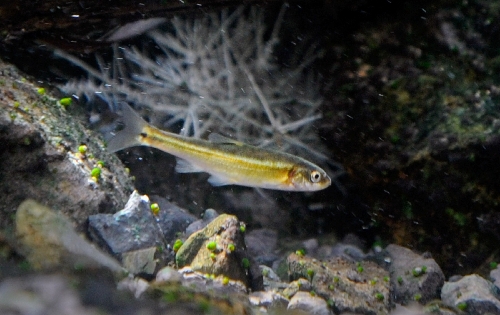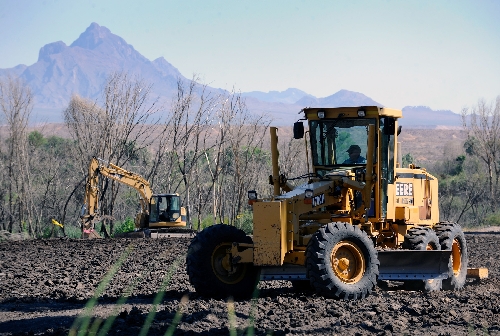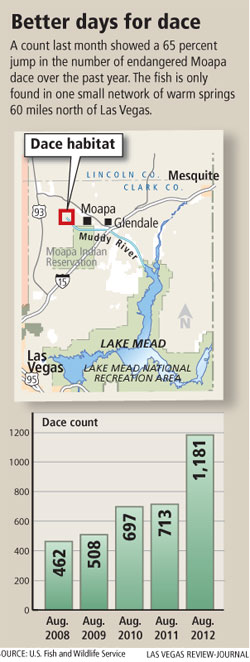Elimination of tilapia helps dace population increase
After three years of modest gains, the number of Moapa dace has shot up in recent months, giving new hope to the legion of researchers and regulators trying to save the endangered fish from extinction.
An exhaustive hand-count last month showed a population of 1,181, a 65 percent jump from the previous year and the highest total since February 2005.
"We're cautiously optimistic," said Amy LaVoie, who manages the 116-acre Moapa National Wildlife Refuge for the U.S. Fish and Wildlife Service. "This has been a difficult species to recover."
The finger-length fish with the black spot on its tail has been found only in a few miles of spring-fed streams about 60 miles north of Las Vegas. It has been under federal protection for more than 40 years, and it is expected to remain that way until at least 75 percent of its historical habitat has been restored and its population holds steady at 6,000 adult fish.
The dace's entire habitat is confined to the refuge, some adjacent private land and the Warm Springs Natural Area, a 1,218-acre tract the Southern Nevada Water Authority bought in 2007 for $69 million.
The wholesale water supplier for the Las Vegas Valley agreed to help protect the fish under a 2006 federal agreement allowing the authority to pump groundwater at nearby Coyote Springs.
LaVoie said the recent population gains likely result from extensive efforts to restore streams in the area to the way they looked decades ago, before the warm headwaters of the Muddy River were diverted for farming, ranching and a few small resorts.
As proof, LaVoie points to a quarter-mile length of new stream habitat built on Southern Nevada Water Authority land just across the road from the refuge. Some 376 dace, nearly a third of the entire population, were counted in that one small stream, which didn't even exist until 2008.
"They wouldn't repopulate an area if the habitat was bad," said Robert Johnson, who manages the Warm Springs Natural Area for the water authority.
The dace's prospects also have been helped by the elimination of tilapia, a non-native fish that showed up in the 1990s and proceeded to eat much of the dace's food, followed by the dace themselves.
Researchers believe they succeeded in removing the last tilapia from the main part of the dace's historic habitat just last year.
Once they are sure the tilapia are gone for good, they plan to remove a barrier that keeps the dace from spreading back into the wider mainstem of the Muddy River.
That probably won't happen for a year or two; but when it does, it could "really let the population take off," said Jon Sjoberg, a supervising fisheries biologist for the Nevada Department of Wildlife.
Right now, the dace is confined to an area of small streams that keep the adult fish from growing to their full potential of up to five inches in length. Once they get back into the mainstem, they can grow. As Nevada Department of Wildlife fisheries biologist Kevin Guadalupe put it: Larger fish produce more eggs, and more eggs produce more offspring.
Guadalupe is on a team of researchers who snorkel through the shallow streams to physically count dace every February and August.
But the fish also are being scrutinized in a number of other rather intrusive ways.
A few of the tiny creatures have been injected with quarter-inch devices known as nano tags to track their movements and provide clues about their behavior.
Then there is the study by researchers from the University of Arizona, who set up remote video cameras in an attempt to capture, for the first time, footage of dace making more dace.
"We've never fully understood spawning in dace," LaVoie said.
"They're real private about that," Fish and Wildlife Service spokesman Dan Balduini added.
Last month's count marked the first time the dace population has exceeded 1,000 since 2007, when their numbers suddenly plummeted to less than 500 for reasons researchers still don't entirely understand.
The February 2008 count of 459 was the lowest ever recorded and caused some to speculate that the dace could be on its way out.
The outlook is more hopeful today, but some believe no amount of work will save the dace, especially if the water authority and others are allowed to pump so much groundwater from the area that the springs decline or run dry.
Rob Mrwoka is an ecologist in Nevada for the Arizona-based Center for Biological Diversity. In a federal lawsuit filed in 2010, his organization accused the Fish & Wildlife Service of jeopardizing endangered dace by entering into an agreement that allowed the water authority to pump groundwater in Coyote Springs Valley.
Mrwoka said he applauds efforts to restore natural stream channels and to remove non-native predators from the dace's habitat, but more hurdles lie ahead.
"Even with the encouraging census, we are still a far cry from saying the dace is out of trouble," he said. "The proposed groundwater developments greatly add to the uncertainty."
Water authority spokesman Bronson Mack said the wholesale water agency began pumping groundwater from Coyote Springs Valley, about 15 miles west of the refuge, in November 2010.
So far, test pumping ordered by state water regulators appears to have caused a slight reduction in flows from some higher-elevation springs in the Warm Springs area. Mack said the decline is well within acceptable levels spelled out in a monitoring agreement involving the authority, federal regulators and other interested parties.
Contact reporter Henry Brean at hbrean@reviewjournal.com or 702-383-0350.
More information
Moapa Valley National Wildlife Refuge




















